Hyperactive drones
Synopsis: Drones occupy age-related locations in the nest and exhibit coordinated periodic hyperactivity. How was this determined and do these insights help our beekeeping?
Introduction
I’ve always enjoyed Robert Macfarlane’s writing. He assembles words that capture a scene or a feeling (or both) in ways many writers never achieve.
In the opening paragraph of Underland – a book about the land underground – Macfarlane describes the field as he approaches the entrance to a cool, dark, sunken labyrinth {{1}} like this …
Late summer heatwave, heavy air. Bees browsing drowsy over meadow grass.
… contrasting the stygian world with the “very beautiful” upper world.
As a beekeeper writing this post in early November, with a bitter westerly herding hail-laden squalls in from the Atlantic, those first five words feel like a lifetime away.
However, as a beekeeper, although I love the juxtaposition in ‘browsing drowsy’, I’m struggling with it as a description of foraging honey bees.
Firstly, there’s little ‘drowsy’ about their activity. They seem to constantly be on the move, darting from flower to flower, testing the nectaries or pollen levels … pausing to collect, or moving quickly on.
Secondly, they don’t do a whole lot of ‘browsing’ on meadow grass. In fact, if you look at some of the data from the National Honey Monitoring Scheme, grasses barely register on the pollen types they are recording in samples.
This is one of the reasons why advocates for honey as a ‘cure’ for hay fever are confusing a good story with scientific reality.
Perhaps Macfarlane is referring to bumble bees?
And, if the foragers aren’t drowsy, what about the drones?
Down the rabbit hole
Those sentences from Underland got me thinking about the differences in the flight of workers and drones.
Although it’s several weeks since I’ve even seen a drone my recollection is that they leave the hive purposefully, rising skywards in spiralling arcs, before setting off towards the horizon, presumably en route to a drone congregation area in the hope of a little honey bee hanky panky.
Which made me remember the noise they make leaving the hive. It’s very distinctive and clearly different from the background hum of the foragers going to and fro.
For a start, the sound of a drone in flight is louder. It also seems to be at a different frequency. This is reflected in the name drone which has Germanic origins and means making a ‘loud, continuous sound’ and dates back to the 5th or 6th century.
And that led me down an internet rabbit hole searching for why drones and foragers sound different.
Is the frequency really different? Foragers beat their wings at about 230 Hz but I’ve failed to locate any comparative data on drones.
Interestingly, wingbeat frequency is also influenced by temperature and humidity, but under the same conditions the drones sound very different.
How does wing area influence this? Would the larger wing of a drone flapped {{2}} at 230 Hz sound different?
Dunno … I can’t answer any of those questions.
Yet.
There’s another difference between workers and drones. On a ‘good flying day’, with the foragers busy from early ’til late, drone activity occurs in a relatively narrow timeframe, usually early/mid afternoon.
It almost appears synchronised.
And, it turns out, that is something we are starting to understand.
Drone flight activity
Yves Le Conte published a descriptive study of the flight activity of honey bee drones which, helpfully, is the title of the paper (Reyes et al., 2019).
They took 100 newly-emerged (<12 hours old) drones labelled with a unique numbered disk and placed them in a hive with a modified entrance. The drones had to traverse a narrow transparent tube under the unflinching gaze of a high-resolution camera that recorded the drones in two locations within the tube.
The direction of motion (entering or exiting the hive) was determined and the number on the disk was deciphered using optical character recognition software.
Repeated studies were conducted in May/June (Spring) and June/July (Summer) using hives located in Avignon, France (~43.9°N). The hive with labelled drones was placed 20 metres away from other hives and separated by dense vegetation to reduce drifting.
Recordings were made over the entire period until the last drone left the hive. In parallel, worker activity was recorded, as was the weather.
A drones life
To summarise several pages of results …
After emergence the drone remains in the hive for a few days. It then goes on 8-9 orientation flights of ~15 minutes duration over a 2-3 day period before spending the next 5 days (summer) or 12 days (spring) in the hive, even on days with great weather.
After this period of striking inactivity the drones embark on the longer mating flights, taking several per day – though not always on consecutive days – until they failed to return … indicating success (or, of course, abject failure).
Rather than regurgitate reams of results with standard deviations and significance I’ve simply tabulated the average figures for a number of the measurements recorded.
| Measurement | Spring drones | Summer drones |
|---|---|---|
| Mean age first flight (days) | 5.6 | 7.2 |
| Mean age last flight (days) | 19.9 | 15.2 |
| Maximum lifespan (days) | 33 | 21 |
| Orientation flights (age in days) | 6-8 | 7-9 |
| Orientation flights (duration, minutes) | 15.2 | 14.8 |
| Orientation flights per day | 3.3 | 2.7 |
| Mating flights onset (days) | 21 | 13 |
| Mating flight average duration (minutes) | 31.5 | 27.4 |
| Mating flights per day | 4.3 | 5.7 |
| Total mating flights | 22 | 20 |
| Drones not taking mating flights (%age) | 48 | 19 |
The longest mating flights (of 2-2.5 hours) were made by the oldest drones and were generally one of the last flights they made.
Although there are a few significant differences in the results observed for spring vs. summer drones, they are broadly similar in the number and duration of orientation and mating flights they took.
Timing of flights
The time of the day at which these drone orientation and mating flights took place (blue line, below) did not necessarily correlate with worker flight activity in the colonies (black line, below).
Although a few drones left the hive very early or late in the day, the vast majority of flights occurred between 2 pm and 6 pm, with activity peaking at 4 pm {{3}}.
Even if the weather was good, mature drones (i.e. those that had already started taking mating flights) did not necessarily fly every day.
However, if the weather was unsuitable, drone flights were reduced. Wind speeds of over 30 km/h stopped most drone activity as did any rain … but this study was conducted in the south of France and it didn’t rain in the summer!
Drifting
It’s well known that drones are accepted by colonies other than those they were raised in.
This movement of drones from their original hives to others is termed drifting and – if similar to worker behaviour – primarily occurs when returning from orientation flights.
Le Conte and colleagues used a slightly different definition of drifting. They defined this as drones that left the hive but reappeared 1-7 days later before the onset of mating flights. Using this definition, 3-7% of drones drifted during the study.
Conversely 50-80% of drones remained faithful to their original colony from introduction until mating flights started.
The remainder – those that didn’t drift away and back again – either died in the original hive (a single digit percentage), or left and did not return. Some of the latter probably drifted to another colony but were unmeasurable as only one hive had a monitored entrance.
And?
As a reasonably observant beekeeper some of these results were unsurprising. For example, I knew that drones mainly fly in the afternoons, albeit a bit earlier in my more northerly location.
I also had a pretty fair idea about the general timing of orientation and mating flights, based upon the known maturation stages in the life cycle of drones.
However, the inactive period between the orientation flights and the mating flights was a surprise, and the number and duration of the different flight types was also news to me.
Will it improve my beekeeping? Probably not.
Will it enhance the enjoyment of my beekeeping? Quite possibly … bees are fascinating insects and it’s good to have a better idea of what’s going on.
But what are the drones doing during that 5 or 12 day hiatus between their orientation and mating flights?
To understand that we need to observe what’s going on inside the hive, rather than recording drones exiting and entering the hive.
And – fortunately – there’s a recent study by Michael Smith and colleagues (Neubauer et al., 2023) that has done just that.
Hyperactive drones
Recording in-hive activity is a lot more complicated than scoring and identifying incoming and exiting drones.
Unlike a narrow (single bee width) entrance tunnel there’s a mass of other bees within view.
That is, if you could see them, which you can’t … because it’s totally dark.
To circumvent this problem scientists uniquely tag bees with a small labelled paper disc and then place them in an observation hive illuminated using infrared light (IR; 850 nm). Bees cannot ‘see’ IR. The observation hive is located within a building with a tunnel exit to allow the bees to fly freely.
Rather than manually recording things {{4}} the frames (stacked above each other so bees cannot hide between them) are videoed using a IR-sensitive camera, with image analysis software used to decode the location and movement – or lack of it – of every uniquely labelled and unambiguously identifiable bee.
Location sounds simple, but isn’t. Is the drone on brood comb or stores? The brood nest and area of stores changes over the duration of the study, so they also had to map the frames to work out “what’s where” in the hive.
Which is exactly what Neubauer et al., (2023) did.
They labelled 192 drones and recorded them at 3 frame per second for at least 20 days {{5}}.
What did they observe?
Immobility and hyperactivity
The drones spent most of their in-hive time more or less completely immobile. They only moved at about 0.08 cm/s. In contrast, workers move at least 3 times this speed, at 0.262 cm/s.
To put that into context; at 0.08 cm/s a drone would take about 90 minutes to cross the diagonal of a National brood frame.
Hardly Speedy Gonzales.
However, with the onset of orientation flights, drones exhibited periodic hyperactivity, dashing about at a blistering 0.355 cm/s (equivalent to sprinting across a brood frame diagonal in just 20 minutes).
These hyperactive periods occurred when drones were near the hive entrance, when they made flights from the entrance and when the weather was warm and sunny.
In contras the Reyes et al., work already discussed the drones appeared to fly daily if the weather was suitable. This isn’t mentioned further but is a discrepancy between the studies; however, this may reflect cumulative drone activity in the Neubauer study compared to individual activity in the Reyes work … but remember, the drones in each experiment are the same age.
However, between the orientation and mating flights there was a reduction in the periodic hyperactivity and flights, but this coincided with a period of lower temperatures and reduced sunshine, so it’s not entirely clear whether this was the in-hive hiatus seen by Reyes, or simply due to less good weather.
Hangin’ around
Have you ever observed where adult drones are located in the hive?
Late in the season they’re usually on the outside frame nearest the entrance.
By recording drone location and age Neubauer et al., (2023) showed that drones occupy distinct locations within the hive as they mature:
- young drones (those yet to complete their orientation flights; <10 days old) were found on brood comb in the centre of the nest
- ‘teenager’ drones (which have completed the orientation flights but yet to start mating flights; >10 days) occupied the nest periphery i.e. bordering the brood
- mature drones (>14-19 days) were closer to the nest entrance
All together now
By analysing the timing of the onset and duration of drone hyperactivity it was clear that the start and end of this behaviour was synchronised.
Both the onset and duration differed on different days; for example it ranged in length from 15 minutes to 3 hours and started between 1 pm and 4 pm. However, on any day up to 70% of the drones over 7 days of age (younger drones were rarely hyperactive) exhibited this synchronised behaviour.
Hyperactivity appeared to be weather-dependent.
On dull days (<5 hours sunshine {{6}} ) the drones remained essentially immobile. Hyperactivity on the following day was only for ~15 minutes. However, I don’t really think there was sufficient poor (dull) weather during the study to be sure this wasn’t phenomenology … is there really a correlation, or did it just happen once?
What is clear – because there were lots of sunny days – is that the onset of the hyperactive period occurred just after the sunniest part of the day.
How do the bees know when the sunniest part of the day is? This isn’t necessarily at solar noon.
Finally, during these hyperactive periods most drones made one or two flights from the hive, averaging 24 minutes duration.
These sound remarkably like mating flights to me … or at least flights of a similar duration to mating flights, as some drones making them would still not be sexually mature (which occurs 10-16 days after emergence).
Do the maths
The final part of the study is a mathematical model of the induction and cessation of hyperactivity.
The model addressed whether the synchronisation could arise solely due to environmental clues such as sunlight or temperature, or whether communication between drones contributed to the the coordinated behaviour.
This is beyond the scope of this post and well beyond my primitive maths skills.
Suffice to say that communication markedly enhanced the synchronisation of hyperactivity in their model.
Neubauer et al., (2023) termed this communication ‘social information’.
This is a much more appropriate term; it may not involve direct communication (e.g. involving trophallaxis or pheromones) between drones at all. For example, the authors suggest that:
conspicuous hyperactivity may itself be the social cue that helps to synchronise all the drones across the colony
Other social information (cues) may also exist, such as simple proximity.
Interestingly, in the studies of drone location within the hive Neubauer and colleagues had identified that the presence of one age-matched cohort of drones on a frame influenced the location of a different age-matched cohort.
Further studies are needed.
Droning on
I’ve done more than enough.
These two studies provide some insights into the lives of drones. As with the other components of the hive – the workers, queen, comb, pheromones etc. – when it’s looked at carefully it raises at least as many questions as it answers.
I’ve highlighted some discrepant results. These may reflect different experimental setups; although both were 3-5 frame nucs ‘spiked’ with labelled drones the Neubauer study required that all faces of the frame were ‘exposed’ for observation. I don’t see how this could induce mating-length flights in bees that had only just completed their orientation flights. But it might.
The ‘social information’ – assuming it exists at all (remember, it’s predicted from a mathematical model) – needs more work before it is identified. The influence of circadian rhythms also needs to be clarified.
Why, not how?
Why is drone hyperactivity synchronised?
In some ways this is a more interesting question.
Do coordinated drone flights increase reproductive success?
The detection of this behaviour suggests that it does. It should result in higher densities of drones in the congregation areas, a prerequisite for efficient queen mating. In addition, from the aspect of an individual drone, if hundreds fly simultaneously it should reduce predation from insect-eating birds. Conversely, early-flying drones (ahead of the pack) might have a competitive advantage over their ‘lazy’ brothers, though flying too early would risk missing the arrival of the virgin queen. Again … more thought and work required.
Do these insights help our beekeeping?
Probably not … but that doesn’t mean it’s not interesting.
I don’t expect to see drones until late April or early May next year, perhaps even a full 6 calendar months from the date this post appears online {{7}}. However, when I do, I’ll have a better idea of the age of drones in different parts of the brood nest and a little more understanding of why there were no drones flying before lunch when the sky is full of them three hours later.
But well before then – actually in the next week or two – I need to treat colonies with oxalic acid.
And that will be discussed next time {{8}}.
Notes
Don’t read Robert Macfarlane’s Underland if you suffer from claustrophobia. I don’t, or at least I didn’t think I did. However, there were a couple of sections about traversing the ‘Starless rivers’ in the limestone caves in Italy that gave me the jitters and I had to skip over them.
Instead I’d recommend The Old Ways; A Journey on Foot or The Wild Places as less likely to give you sleepless nights.
References
Neubauer, L.C., Davidson, J.D., Wild, B., Dormagen, D.M., Landgraf, T., Couzin, I.D., and Smith, M.L. (2023) Honey bee drones are synchronously hyperactive inside the nest. Animal Behaviour 203: 207–223 https://www.sciencedirect.com/science/article/pii/S0003347223001380.
Reyes, M., Crauser, D., Prado, A., and Le Conte, Y. (2019) Flight activity of honey bee (Apis mellifera) drones. Apidologie 50: 669–680 https://doi.org/10.1007/s13592-019-00677-w.
{{1}}: Not clear whether it’s a cave or a holloway from the context.
{{2}}: They don’t flap … ‘flap’ doesn’t do justice to the amazing, twisting, flexing wingbeat.
{{3}}: Remember the latitude, this is likely to be earlier at higher latitudes.
{{4}}: Only possible if you have eager naive PhD students …
{{5}}: That’s over 5 million individual frames that needed to be analysed.
{{6}}: That’s not what I’d call a dull day!
{{7}}: Unless of course I have a failed queen overwinter.
{{8}}: Unless I think of something I’d prefer to write about … in which case I’d recommend Rational Varroa control … but then I would, wouldn’t I?
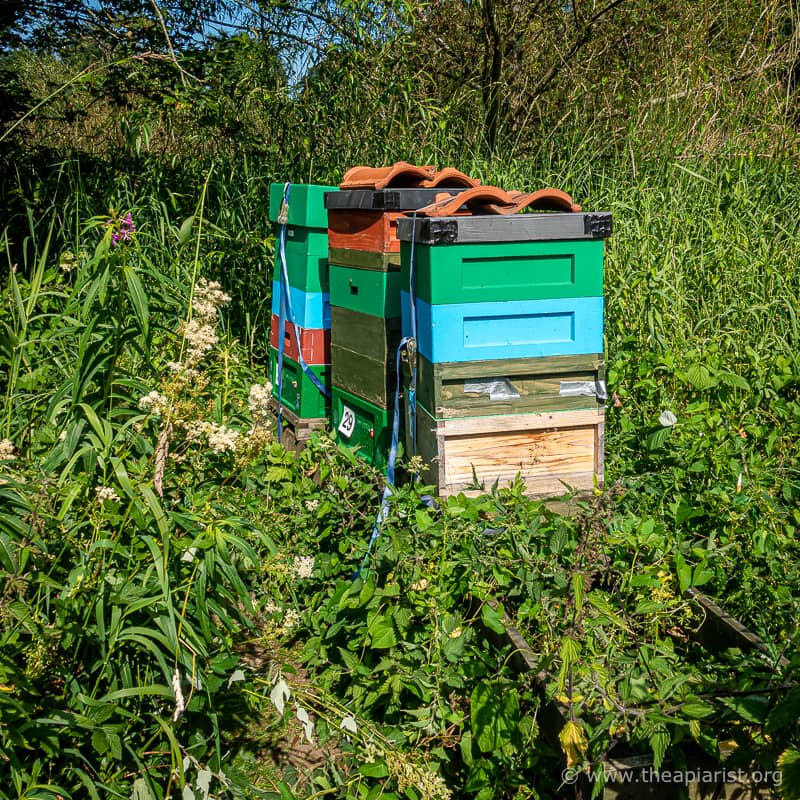
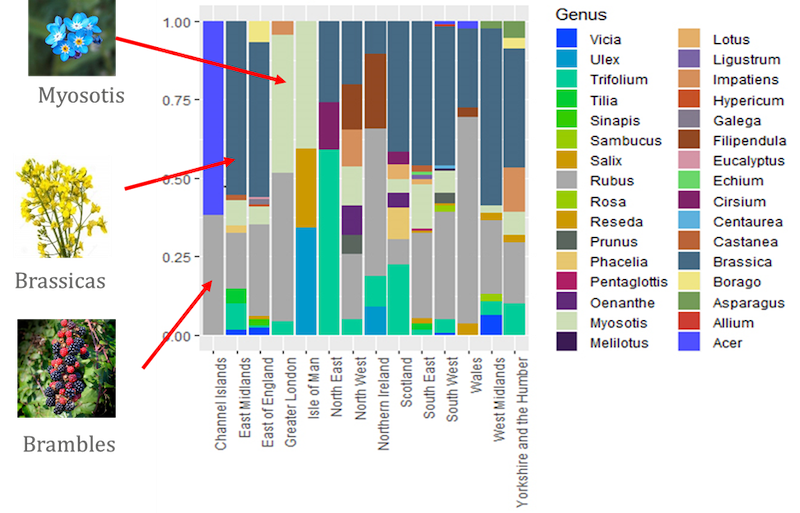
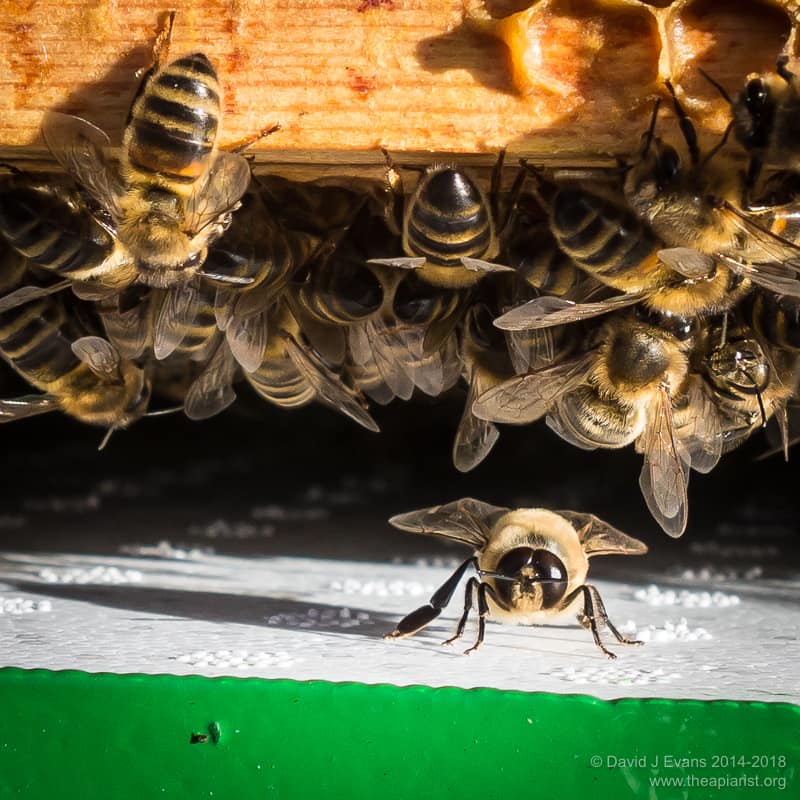

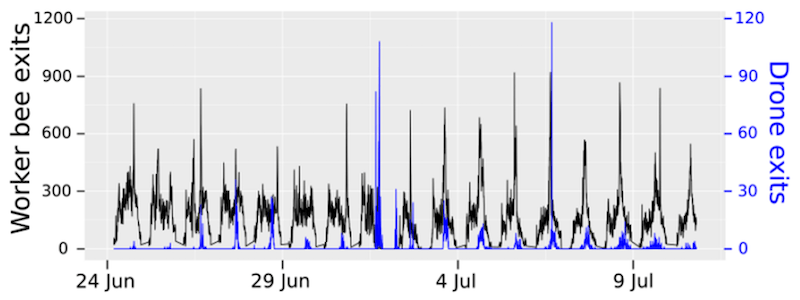
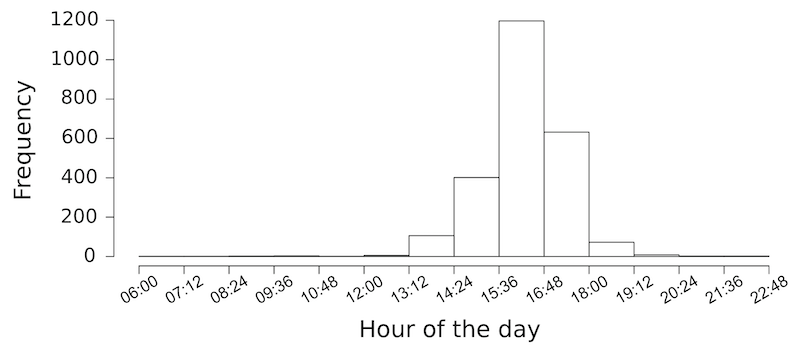


Join the discussion ...